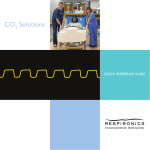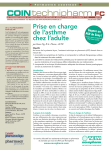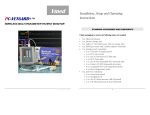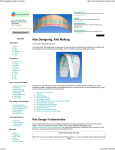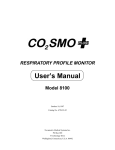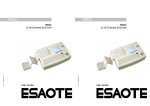Download Quick reference guide
Transcript
CO2 Solutions Quick reference guide The print quality of this copy is not an accurate representation of the original. The print quality of this copy is not an accurate representation of the original. 2 Contents Why measure CO2? . . . . . . . . . . . . . . . . . . . . . . . . . . . . . . . . . . . . . . . . . . . . . . . . . . . . . . . .4 CO2 technology options . . . . . . . . . . . . . . . . . . . . . . . . . . . . . . . . . . . . . . . . . . . . . . . . . . . .5 The right solution . . . . . . . . . . . . . . . . . . . . . . . . . . . . . . . . . . . . . . . . . . . . . . . . . . . . . . . . .6 Uses of capnography . . . . . . . . . . . . . . . . . . . . . . . . . . . . . . . . . . . . . . . . . . . . . . . . . . . . . . .7 Monitoring with mainstream vs. sidestream CO2 sensors . . . . . . . . . . . . . . . . . . . . . . . . . .8 Zeroing the CO2 sensor . . . . . . . . . . . . . . . . . . . . . . . . . . . . . . . . . . . . . . . . . . . . . . . . . . . .9 Frequently asked questions . . . . . . . . . . . . . . . . . . . . . . . . . . . . . . . . . . . . . . . . . . . . . .10-19 The print quality of this copy is not an accurate representation of the original. 3 Mainstream and sidestream capnography Why measure CO2? Capnography has been shown to be effective in the early detection of adverse respiratory events.1 Capnography provides a rapid and reliable method that may detect life-threatening conditions and helps avoid potentially irreversible patient injury.2 Capnography provides clinicians instantaneous feedback that the endotracheal tube used for mechanical ventilation is correctly positioned to deliver gas to the lungs and that it remains in place throughout any manipulation of the patient. Capnography is the most rapid indicator of missed intubations, kinked tubes or accidental extubation, helping to assure reliable patient safety.3 CO2 monitoring is becoming a global standard of care for patient safety.4,5 The American Society of Anesthesiologists (ASA), the American Association for Respiratory Care (AARC), and the American Hospital Association (AHA) have all adopted standards and guidelines for CO2 monitoring. Many states, such as Florida and New York have laws mandating that every ambulance be equipped with a CO2 measurement device. Europe has also adopted CO2 monitoring in some countries as a result of societal standards and in other countries as a result of individual country law. Due to capnography’s usefulness as a safety monitor and its ease of use, the utilization of capnography is spreading similarly to the way pulse oximetry did. Fueling the increase in the use of capnography is miniaturization and technology advancements. Capnographs and capnometers today are small, very robust, and easy to use. This allows easy integration into patient monitors, defibrillators and ventilators, making capnography easy and inexpensive for the clinician. With Philips Respironics technology, the ease of use is enhanced because of the CO2NNECT & GO capnography capabilities. The print quality of this copy is not an accurate representation of the original. 4 Flexible CO2 monitoring solutions CO2NNECT & GO technology CO2NNECT & GO mainstream and sidestream ETCO2 monitoring allows the customer to match the appropriate technology to the needs of a specific patient by switching easily between mainstream and sidestream monitoring: • Choose Capnostat 5 mainstream sensor for optimal performance in monitoring intubated patients • Select LoFlo sidestream sensor for monitoring non-intubated patients LoFlo sensor supplies Mainstream sensor adapters The print quality of this copy is not an accurate representation of the original. 5 The right solution Mainstream sensor Capnostat 5 sensor for intubated patients • Small, durable, and lightweight mainstream CO2 sensor provides accurate and reliable monitoring for all intubated patients from neonates to adults • No calibration required Capnostat mainstream CO2 sensor Sidestream sensor LoFlo sensor for non-intubated patients • A flexible and compact CO2 sensor that provides consistent and reliable CO2 monitoring of adult, pediatric and neonatal patients. • No calibration required • 50 ml/minute sampling rate LoFlo sidestream CO2 sensor The print quality of this copy is not an accurate representation of the original. 6 The many uses of capnography Ventilator management • Assists in determining when to intubate or extubate • Verification of ET tube placement • Alerts if accidental extubation occurs • On-going airway management • Initial setup, monitoring and weaning from ventilator • Ventilator disconnect detection • Assists in determining hyper and hypo ventilation • Assists in determining deadspace (A-a CO2 gradient) Monitoring and diagnostic • Waveform analysis – breathing pattern assessment • Visualize changes in ventilatory pattern • Assessment of patient/ventilator synchrony • Monitors for over-sedation • Verification of target PaCO2 in head trauma patients • Assists in determining loss of airway control • Assessment of neuromuscular blockade drugs • Evaluation of bronchodilator therapy • Useful in asthma management, especially in the ED • Effectiveness of chest compressions during CPR • Verification of ventilation during transport Hyperventilation Hypoventilation Curare cleft Faulty exhalation valve Cardiogenic oscillations The print quality of this copy is not an accurate representation of the original. 7 Monitoring with mainstream versus sidestream CO2 Sensors Mainstream CO2 sensor CO2 (mmHg) 50 Real Time Sidestream CO2 sensor CO2 (mmHg) 50 37 37 0 0 Real Time • Most appropriate form of ETCO2 monitoring for mechanically ventilated intubated patients5,6 • Used to monitor the ETCO2 of awake, non-intubated patients • On-airway measurement – immediate response • Sample diverted to measurement site from patient interface. • CO2 sensor is located between the ET tube and the breathing circuit • Cannulae available that sample CO2 and deliver O2 simultaneously • Disposable and reusable adult/pediatric and infant/neonatal airway adapters • Cannulae can be placed on patients under masks, such as oxygen delivery or CPAP masks. • The accuracy specifications of the Capnostat 5 (mainstream sensor) and LoFlo (sidestream sensor) are the same • Both monitor patient respiratory rate from 2 to 150 Breaths per minute • Both measure ETCO2 from 0 to 150 mmHg, 0 to 19.7% or 0 to 20 kPa • The Capnostat 5 sensor, LoFlo sensor, and all accessories used with them, are Latex free The print quality of this copy is not an accurate representation of the original. 8 What is a CO2 sensor adapter zero? An “adapter zero” is a quick procedure that adjusts the Capnostat 5 mainstream sensor to the optical characteristics of each compatible airway adapter. An “adapter zero” on the LoFlo module adjusts the sidestream sensor to the characteristics of each cannula, airway adapter or sample line. What are the guidelines to performing an adapter zero? Mainstream CO2 sensor Sidestream CO2 sensor • Procedure is necessary with the first use of the M2501A, Mainstream Capnostat 5 CO2 sensor. • Procedure is necessary when switching from a reusable airway adapter to a disposable airway adapter. • Zeroing is not required when switching adapter sizes only. • Procedure is necessary when requested by the CO2 monitor. • Typical time for zero is 15-20 seconds. • Procedure is necessary with the first use of the M2741A, LoFlo CO2 sensor. • A sample cell zero is not required when switching from one sampling accessory to another. • Procedure is necessary when requested by the CO2 monitor. • Typical time for zero is 15-20 seconds. Never zero the Capnostat sensor or LoFlo sensor without an adapter or sampling kit installed. When zeroing, always remove the adapter or cannula from the patient and keep all sources of CO2 away from the sensor, including your own breath (CO2 is heavier than air). Always refer to the user manual for complete instructions. The print quality of this copy is not an accurate representation of the original. 9 Key questions and answers Frequently asked questions for clinicians Q: How is CO2 measured using the Capnostat 5 mainstream sensor and the LoFlo sidestream sensor? The mainstream and sidestream sensors measure the number of CO2 particles in the exhaled gas using Infrared light. A broad band of light wavelengths are emitted by an Infrared source. The light is then focused by a lens and transmitted across the airway adapter (mainstream sensor) or the sample cell (sidestream sensor). CO2 that passes through the light absorbs some of this light at specific wavelengths. The light is then focused through a filter set at the CO2 absorption wavelength onto a detector. The amount of CO2 in the airway is then determined by measuring the light that was absorbed. Q: When should I use the mainstream or the sidestream capnography sensor? The mainstream and sidestream sensors are often confused as to when or why or how they should be used. Just consider that the end result is the same, which is monitoring ETCO2. The sidestream sensor is commonly used in emergency medicine, procedural sedation, and the mainstream sensor is used on intubated patients. The print quality of this copy is not an accurate representation of the original. 10 Q: Which is more accurate? The mainstream sensor or the sidestream sensor? The accuracy specifications between the Capnostat 5 mainstream CO2 sensor and the LoFlo sidestream CO2 sensor are the same.7,8 The difference between the two sensors is the application and display of the capnogram.The LoFlo sensor is used for non-intubated patients and the mainstream Capnostat 5 sensor is used for intubated patients.The capnogram of the mainstream sensor is “crisper” as sidestream sensor sampling tends to round the capnogram as the gas sample is drawn down the tubing to be measured. Q: I thought that I could use the LoFlo sensor on intubated patients. Doesn’t that make it a mainstream sensor? Yes, you can use the LoFlo sensor on intubated patients.There are sampling kits that have an adapter to connect to an ET tube.These may be used for short term ventilator care. In the presence of high humidity and/or secretions they are not as robust as the Capnostat 5 sensor which is designed for use in these conditions. Using a sidestream sensor on an intubated patient does not make it a mainstream sensor, because a sidestream sensor removes a portion of the patient’s breath, where as a mainstream sensor does not. The print quality of this copy is not an accurate representation of the original. 11 Key questions and answers Frequently asked questions for clinicians (continued) Q: Can I use the LoFlo sensor on neonates? Yes you can. The LoFlo sensor samples at a rate of 50 ml/min. This is comparable to other sampling systems in the market. The LoFlo sensor is primarily used for nonintubated patients including neonates. The deadspace of the neonatal adapter is less than 1 ml, so it is acceptable for use on neonates. In the presence of high humidity, heavy secretions and/or very high respiratory rates, sidestream systems are not as robust as mainstream systems which are designed for use in these conditions. Mainstream technology provides a “crisper” capnogram. But, as with all monitoring technology, the decision to use it or not is always determined by the caregiver. Q: How long can I use the Capnostat 5 sensor adapters and LoFlo sensor sampling kits? You can use either the single patient use (SPU) disposable or the reusable adapters with the Capnostat 5. Regardless of the type, they are designed for long term use. The LoFlo sensor sampling kits are single patient use and the hours of use are as follows. LoFlo sensor sampling kits without Nafion can typically be used up to 12 hours. LoFlo sensor sampling kits with Nafion can typically be used up to 120 hours. The print quality of this copy is not an accurate representation of the original. 12 Q: What is the deadspace of your adapter? CAPNOSTAT 5 sensor adapters Pediatric/Adult = 5 cc of deadspace Infant/Neonatal = <1 cc of deadspace LoFlo sensor sampling adapter kits Pediatric/Adult = 7 cc of deadspace Infant/Neonatal = <1 cc of deadspace Q: How do I determine which adapter to use? CAPNOSTAT 5 sensor adapters Pediatric/Adult = for use on ET Tubes sizes >4.0 mm Infant/Neonatal = for use on ET Tube sizes ≤ 4.0mm LoFlo sensor sampling adapter kits Pediatric/Adult = for use on ET Tubes sizes >4.0 mm Infant/Neonatal = for use on ET Tube sizes ≤ 4.0mm How should I position the CO2 sensors? For the CAPNOSTAT 5 sensor, always keep the windows of the adapter in the vertical position.This will keep water and patient secretions from pooling on the windows. If the LoFlo sensor sampling adapter kit is used on an ET tube, always make sure that the tubing is pointing up.This will keep water and patient secretions from being drawn into the tube. The print quality of this copy is not an accurate representation of the original. 13 Key questions and answers Frequently asked questions for clinicians (continued) Q: What is the best method for dealing with breathing circuit humidity? The Capnostat 5 mainstream sensor is heated close to body temperature to keep the adapter warm, which keeps water vapor from condensing on the windows. When the LoFlo sensor is connected to an ET-Tube, the LoFlo sensor airway adapter kit with Nafion should be used to dry the sample which reduces the amount of condensed water in the sampling line. Water vapor passes harmlessly through the mainstream sensor adapter and the LoFlo sensor sampling line. The LoFlo sensor sampling kit also has a built in filter and water trap to collect any condensed water, keeping it from entering the LoFlo sensor sample cell. Q: What side of the heat/moisture exchange (HME) do I put the Capnostat 5 sensor or LoFlo sensor airway adapter on? The adapter can be placed on either side of the HME, but the recommended placement is as follows: the HME connects to the ET Tube adapter, the Capnostat 5 sensor adapter connects to the HME and the breathing circuit connects to the Capnostat 5 sensor adapter. This will keep the adapter dry. The print quality of this copy is not an accurate representation of the original. 14 Q: What is a normal range of EtCO2? The normal range for ETCO2 is between 32 and 42 mmHg, which is roughly 5%. The Capnostat 5 sensor and the LoFlo sensor measure the patient’s CO2 from 0 to 150mmHg, or roughly 20%. They both measure respiration rates up to 150 breaths per minute. The accuracy range is as follows. 0 – 40 mmHg ± 2 mmHg 41 – 70 mmHg ± 5% of reading 71 – 100 mmHg ± 8% of reading 101 – 150 mmHg ± 10% of reading Q: Does the sensor compensate for anesthetic agents and other gases? Compensations are set in the host monitor by the user for oxygen, helium, nitrous oxide and anesthetic agents. Refer to your user manual for information on setting the compensations. Compensations are not needed for nitrogen or nitric oxide. Q: What is the barometric pressure used for and how do I set it? Barometric pressure is used to convert the numbers from pressure units of mmHg or kPa to percentages. It is also used in correcting for the effects of collision broadening in the gas sample especially in high concentrations. Refer to the user manual for instructions on how to set barometric pressure. Typically, the mean barometric pressure for your area is set. The print quality of this copy is not an accurate representation of the original. 15 Key questions and answers Frequently asked questions for clinicians (continued) Q: How quickly will I see the capnogram and numbers once I turn the monitor on? On start up and after the sensor warms up, perform the airway adapter zero. After connecting to the patient, the Capnostat 5 sensor will display the capnogram within 15 seconds.The LoFlo sensor will display the waveform within 20 seconds.The ETCO2 and respiration rate will display within 30 seconds or less. Remember, that if the sensor has been in a cold car all night, it will take longer to complete the warm up. Always let the sensor warm up to room temperature before use. The print quality of this copy is not an accurate representation of the original. 16 Key questions and answers Frequently asked questions for biomedical engineers What are the maintenance requirements for the CO2 sensor? There is no required routine maintenance or required field calibration for the Capnostat 5 sensor or the LoFlo sensor. The reason no calibration is required is that the Capnostat 5 sensor and the LoFlo sensor are calibrated at the factory and remain stable over time. The Capnostat 5 sensor and the LoFlo sensor store calibration information and continually validate the stored information. If an error is recognized, the sensor will send an error message. Philips recommends a yearly Mainstream CO2 Accuracy Check, Sidestream CO2 Accuracy Check and Flow Check to the sensors. The system is checked using a certified calibration gas. For the LoFlo sensor, a flow check can be performed using a calibrated flowmeter as desired. Q: Q: What is a zero and when do I do this? A zero is performed whenever a Capnostat 5 sensor is connected to the monitor for the first time. Thereafter, perform a zero whenever a different style adapter is installed, such as when changing from reusable to single patient use or when the system displays a message to perform a zero. It is not necessary to perform a zero when changing types within the same adapter style. For example, when changing from a neonatal single patient use adapter to an adult single patient use adapter it is not necessary to perform a zero. Never zero the Capnostat 5 sensor or the LoFlo sensor without an adapter or sampling kit installed. When zeroing, always keep all sources of CO2 away from the sensor, including your own breath. The zero only takes 15 to 20 seconds. The print quality of this copy is not an accurate representation of the original. 17 Key questions and answers Frequently asked questions for biomedical engineers (continued) Is a zero a calibration? Not really. The function of a zero is to identify the optical characteristics (light transmission) of the adapter windows. The reusable adapter windows are sapphire and the single patient use adapters are plastic. The Capnostat 5 sensor identifies the adapter by the adapter windows and this is done by performing a zero. Q: Q: How can I get the calibration gas? The Philips Respironics part numbers are; M2506A Calibration Gas – 1 cylinder M2505A Gas regulator – 1 gas regulator Q: How do I clean the Capnostat 5 sensor and the LoFlo module? Use a cloth dampened with isopropyl alcohol 70%, a 10% aqueous solution of sodium hypochlorite (bleach), disinfectant spray cleaner such as Steris Coverage Spray HB, ammonia, or mild soap. Wipe down with a clean water-dampened cloth to rinse and dry before use. Make certain that the sensor windows are clean and dry before reuse. The print quality of this copy is not an accurate representation of the original. 18 Q: What can I use to clean the Capnostat 5 sensor reusable airway adapters? Clean by rinsing in a warm soapy solution followed by soaking in a liquid disinfectant such as isopropyl alcohol 70%, a 10% aqueous solution of sodium hypochlorite (bleach), a gluteraldehyde 2.4% solution such as Cidex Plus®, Steris® System 1, or ammonia. It should then be rinsed thoroughly with sterile water and dried. The reusable adapters may be sterilized using the methods listed below: Steam Autoclave - adult adapters only. Ethylene Oxide (ETO) – 1.5 hours exposure. Soak in Cidex Plus solution for 10 hours. Soak in Perasafe solution for 10 hours. Steris System 1 Before reusing the adapter, ensure the windows are dry and residue free and that the adapter has not been damaged during handling or the cleaning/disinfecting process. Q: Through how many sterilization cycles can I use the reusable airway adapters? The reusable adapters are intended to be capable of being cycled 100 times using the disinfecting and sterilization methods described above. The print quality of this copy is not an accurate representation of the original. 19 1 2 3 4 5 6 7 8 Gravenstein JS, Jaffe MB, Paulus DA(eds). Capnography: Clinical Aspects – Chapter 2 – Capnography and Respiratory Assessment Outside of the Operating Room. Thys F, Elamly A, Marion E, Roeseler J, Janssens P, El Gariani A, Meert P, Verschuren F, Reynaert M. PaCO2/ETCO2 gradient: Early indicator of thrombolysis efficacy in a massive pulmonary embolism. Resuscitation. 2001; 49 (1): 105-8. Falk JL, Sayre MR. Confirmation of Airway Placement. Prehospital Emergency Care. 1999; 3(4): 273-278. American Society of Anesthesiologists (ASA). Basic Standards for Intraoperative Monitoring; 1999. Gravenstein JS, Jaffe MB, Paulus DA(eds). Capnography: Clinical Aspects: Cambridge University Press: Cambridge, UK, 441 pp, 2004. Michael B. Jaffe, PhD, “Mainstream or Sidestream Capnography?” Respironics Novametrix, Inc. Wallingford, CT. Page 1-14. Capnostat 5 Mainstream CO2 Sensor, Respironics 2007. LoFlo Sidestream CO2 Sensor, Respironics, 2007. If you have more questions on our capnography solutions, please contact your PMD patient monitoring or supplies partner. Cidex Plus is a registered trademark of ADVANCED STERILIZATION PRODUCTS, Division of Ethicon Inc., a Johnson & Johnson company. STERIS SYSTEM 1 is a registered trademark of the STERIS Corporation. CAPNOSTAT, LoFlo and CONNECT & GO are trademarks of Respironics, Inc. and its affiliates. ©2010 Koninklijke Philips Electronics N.V. All rights are reserved. Philips Healthcare reserves the right to make changes in specifications and/or to discontinue any product at any time without notice or obligation and will not be liable for any consequences resulting from the use of this publication. Philips Healthcare is part of Royal Philips Electronics www.philips.com/healthcare [email protected] fax: +31 40 27 64 887 Printed in The Netherlands. 4522 962 57411 * FEB 2010 The print quality of this copy is not an accurate representation of the original.




















